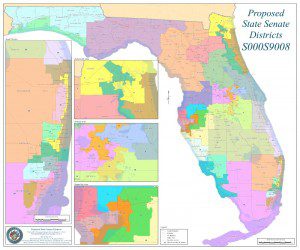The second draft of the Legislature’s redistricting plan for the state Senate answered all of the objections of the Florida Supreme Court to the first proposal and should get justices’ approval, according to a Senate brief in the case.
The brief, filed in response to complaints by the Florida Democratic Party, a coalition of voting-rights groups and the NAACP, came a week before oral arguments on the plan before the court. Also on Friday, the justices issued an order dividing two hours of arguments among the Senate and the groups opposing the plan.
Lawyers for the upper chamber argued in the 100-page filing that the new plan, approved by the Legislature after justices rejected the first draft, “addressed each of the flaws this Court found.”
The court threw out the Senate maps as part of its first review of redistricting proposals under the anti-gerrymandering Fair Districts standards, approved by voters in a November 2010 referendum.
The brief also flayed the arguments raised by the opponents, saying that many of them attempt to draw the court into reconsidering districts that passed in the first review.
“The issue is whether the Legislature complied with the Court’s specific mandate, not whether other districts that this Court either did not find invalid or specifically found valid comply with constitutional standards,” the brief says.
The brief is signed by Raoul Cantero, a former Supreme Court justice who is representing the Senate.
Some of the arguments revolve around Central Florida, where the court specifically rejected an “appendage” to a district that would have prevented Senate Majority Leader Andy Gardiner, R-Orlando, from facing Sen. David Simmons, R-Maitland, in a primary.
Opponents have argued that the new plan simply adds the appendage to a different district. And while it would pair Gardiner and Simmons, critics say, that is an illusion because Simmons has said he would move to a different district to avoid the face-off.
“But the Senate cannot confine Senator Simmons to his current residence or disable him from seeking reelection,” the brief argues. “Indeed, a number of House incumbents who were paired in the House plan the Court approved will move and seek reelection in different districts.”
Senate lawyers also contend that there is no way to completely dismantle the appendage without blending the white voters who reside there into one or both of the minority districts that border it. That would weaken the ability of the minority communities in those districts to elect candidates of their choice, violating another constitutional standard.
The brief also lashes out at plans proposed by the coalition of voting-rights groups — which includes the League of Women Voters of Florida, Common Cause Florida and the Hispanic advocacy group National Council of La Raza — and the Florida Democratic Party. Both plans, it says, are actually gerrymandered to give Democrats a better chance to take the Senate than they would have under the Legislature’s proposal.
And those proposals are unnecessary, the Senate argues, because its map is good enough.
“The voters who approved Amendment 5 never intended to transform redistricting into a tournament, or place every competitor that enters the arena on equal footing with the Legislature,” the brief says.
The court must rule by early May.
By Brandon Larrabee


